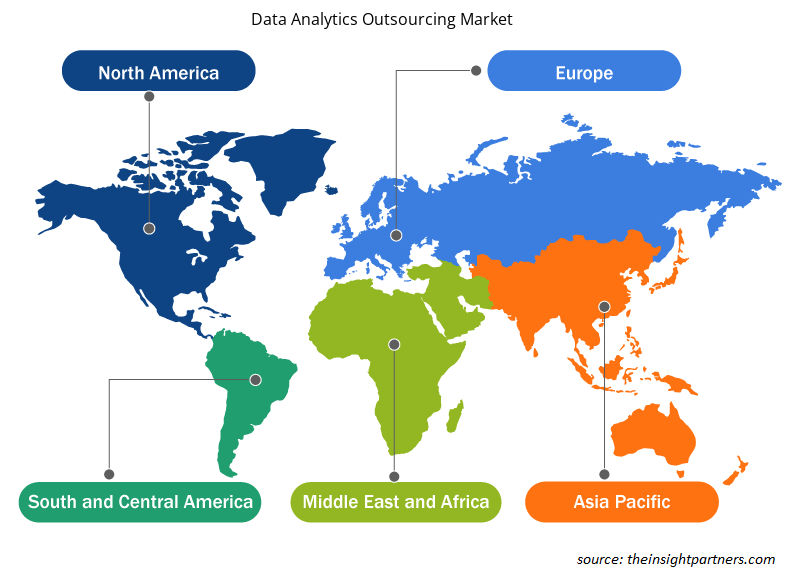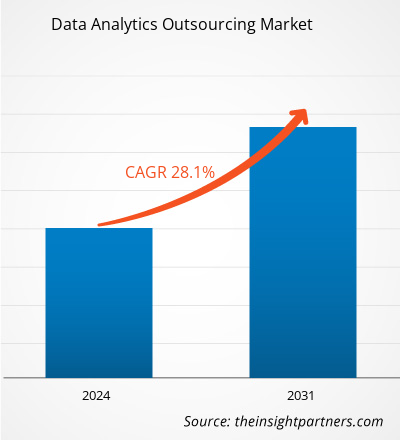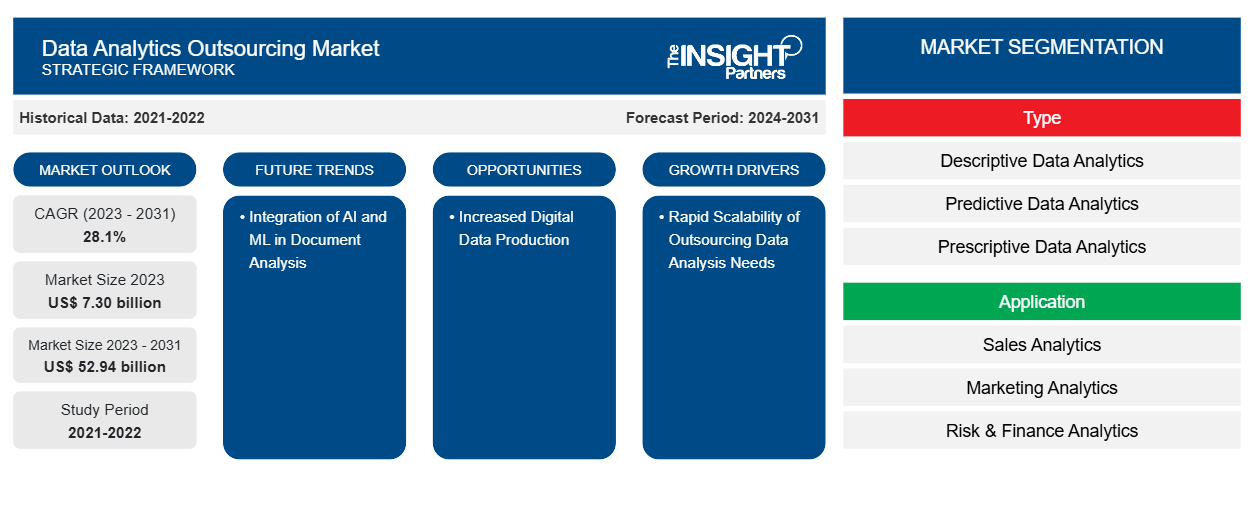Der Markt für das Outsourcing von Datenanalysen soll von 7,30 Milliarden US-Dollar im Jahr 2023 auf 52,94 Milliarden US-Dollar im Jahr 2031 anwachsen. Der Markt für das Outsourcing von Datenanalysen soll in den Jahren 2023–2031 eine durchschnittliche jährliche Wachstumsrate (CAGR) von 28,1 % verzeichnen. Das Outsourcing von Datenanalysen ist eine kollaborative Strategie, bei der ein Unternehmen seine Daten einem Dienstanbieter anvertraut und intelligente Informationen erhält.
Marktanalyse für das Outsourcing von Datenanalysen
Künstliche Intelligenz (KI) hat Menschen in vielen Bereichen der Datenanalyse ersetzt und erfordert weniger manuelle Arbeit. Daher konzentriert sich das Outsourcing von Datenanalysen darauf, wie Menschen ein ML-Modell effizient entwerfen und trainieren können, anstatt Offshore-Mitarbeiter zu verwalten. Die groß angelegte Datenproduktion hat Unternehmen dazu ermutigt, nach Einblicken in die Verbrauchersegmentierung zu suchen, die Präferenzen innerhalb jeder Kategorie zu verstehen, über Verhaltensänderungen auf dem Laufenden zu bleiben und Personalisierung vorzunehmen. Aufgrund der zunehmenden Internetnutzung haben Unternehmen jetzt Zugriff auf eine riesige Menge organisierter und unstrukturierter Daten.
Marktübersicht zum Outsourcing von Datenanalysen
Das Outsourcing von Datenanalysen ist eine kollaborative Strategie, bei der ein Unternehmen seine Daten einem Dienstanbieter anvertraut und intelligente Informationen erhält. Gleichzeitig kümmert sich der Anbieter um alles andere, einschließlich Einrichtung und Support der Infrastruktur, Datenverwaltung und -analyse. Das Outsourcing von Datenanalysen an erfahrene Dienstanbieter verbessert die Genauigkeit der Datenverarbeitung, rationalisiert damit verbundene Verfahren und bietet bessere Erkenntnisse für fundierte Entscheidungen. Darüber hinaus verwenden Unternehmen, die Datenanalysen auslagern, hochmoderne Tools und Technologien, die ständig aktualisiert werden, um ihren Kunden die bestmöglichen Ergebnisse zu bieten. Im Bankensektor kann Datenanalyse für eine Vielzahl von Zwecken eingesetzt werden, von der Verbesserung der Cybersicherheit bis zur Minimierung der Kundenabwanderung. Banken können zusätzliche Daten aus externen Quellen, wie z. B. Handels-, Regulierungs- und Social-Media-Engagement, erhalten und verwenden, sobald diese verarbeitet und analysiert wurden.
Passen Sie diesen Bericht Ihren Anforderungen an
Sie erhalten kostenlos individuelle Anpassungen an jedem Bericht, einschließlich Teilen dieses Berichts oder einer Analyse auf Länderebene, eines Excel-Datenpakets sowie tolle Angebote und Rabatte für Start-ups und Universitäten.
-
Holen Sie sich die wichtigsten Markttrends aus diesem Bericht.Dieses KOSTENLOSE Beispiel umfasst eine Datenanalyse von Markttrends bis hin zu Schätzungen und Prognosen.
Treiber und Chancen auf dem Markt für das Outsourcing von Datenanalysen
Erhöhte Produktion digitaler Daten kommt dem Markt zugute
Das Zeitalter der Digitalisierung hat zu einer erhöhten globalen Generierung digitaler Daten geführt. Die weit verbreitete Nutzung digitaler Geräte wie Smartphones und Computer hat zu einem Anstieg der Ausgaben für digitale Daten geführt. Die wachsende Popularität des Internets der Dinge (IoT) und der von seinen Geräten gesammelten Daten tragen zu diesem Anstieg bei. Datenanalysten haben Schwierigkeiten, enorme Mengen digitaler Daten zu verarbeiten und zu interpretieren. Unternehmen lagern Datenanalyselösungen zunehmend aus, da mit internen Lösungen hohe Kosten und Anfangsinvestitionen verbunden sind. Outsourcing-Dienste können Unternehmen dabei unterstützen, schnell analytische Rahmenbedingungen zu schaffen, die andernfalls schwierig oder zeitaufwändig sein können.
Schnelle Skalierbarkeit des Outsourcings von Datenanalyseanforderungen
Outsourcing-Dienste können Unternehmen auch dabei helfen, schnell ein Analyse-Framework zu entwickeln, was mit den internen Kapazitäten eines kleinen oder mittleren Unternehmens sonst schwierig, wenn nicht gar unmöglich und teuer wäre. Darüber hinaus kann es ein erheblicher Vorteil sein, die Technologie und Ressourcen des ausgelagerten Anbieters zu nutzen, um die betriebliche Effizienz von Datenanalyse-Tools und -Prozessen zu steigern, beispielsweise durch die Implementierung eines fortschrittlichen Rechenzentrums, robotergestützter Prozessautomatisierung oder Cloud-basierter Software. Laut AMR kann das Outsourcing der Datenanalyse an einen Drittanbieter einem Unternehmen auch dabei helfen, kreativere Lösungen zu nutzen, die es möglicherweise zuvor nicht erkundet hat. Kleine und mittlere Unternehmen können solche Fachkenntnisse möglicherweise nicht intern einsetzen.
Segmentierungsanalyse des Datenanalyse-Outsourcing-Marktberichts
Wichtige Segmente, die zur Ableitung der Marktanalyse für das Outsourcing von Datenanalysen beigetragen haben, sind Typ, Anwendung und Endbenutzer.
- Basierend auf dem Typ ist der Markt für das Outsourcing von Datenanalysen in deskriptive Datenanalysen, prädiktive Datenanalysen und präskriptive Datenanalysen segmentiert.
- Nach Anwendung ist der Markt in Verkaufsanalysen , Marketinganalysen, Risiko- und Finanzanalysen und Lieferkettenanalysen segmentiert.
- Basierend auf dem Endbenutzer ist der Markt für das Outsourcing von Datenanalysen in die Bereiche BFSI, Gesundheitswesen, Einzelhandel, Fertigung, Telekommunikation sowie Medien und Unterhaltung segmentiert.
Marktanteilsanalyse für das Outsourcing von Datenanalysen nach geografischen Gesichtspunkten
Der geografische Umfang des Berichts zum Outsourcing von Datenanalysen ist hauptsächlich in fünf Regionen unterteilt: Nordamerika, Asien-Pazifik, Europa, Naher Osten und Afrika sowie Südamerika/Süd- und Mittelamerika. Die steigenden Daten zur sozialen Durchdringung weisen versteckte Muster auf, die Standardanalysetools nicht erkennen können. Laut We Are Social betrug die aktive Durchdringung sozialer Netzwerke in China und den Vereinigten Staaten im vergangenen Jahr 64,6 % bzw. 72,3 %, was auf ein hohes Volumen an Datengenerierung hinweist, das Analysen erfordert. Dies ermutigt Unternehmen im ganzen Land, Datenanalysen auszulagern.
Regionale Einblicke in den Markt für Datenanalyse-Outsourcing
Die regionalen Trends und Faktoren, die den Data Analytics Outsourcing-Markt im Prognosezeitraum beeinflussen, wurden von den Analysten von Insight Partners ausführlich erläutert. In diesem Abschnitt werden auch die Segmente und Geografien des Data Analytics Outsourcing-Marktes in Nordamerika, Europa, im asiatisch-pazifischen Raum, im Nahen Osten und Afrika sowie in Süd- und Mittelamerika erörtert.

- Erhalten Sie regionale Daten zum Data Analytics-Outsourcing-Markt
Umfang des Marktberichts zum Outsourcing von Datenanalysen
| Berichtsattribut | Details |
|---|---|
| Marktgröße im Jahr 2023 | 7,30 Milliarden US-Dollar |
| Marktgröße bis 2031 | 52,94 Milliarden US-Dollar |
| Globale CAGR (2023 - 2031) | 28,1 % |
| Historische Daten | 2021-2022 |
| Prognosezeitraum | 2024–2031 |
| Abgedeckte Segmente |
Nach Typ
|
| Abgedeckte Regionen und Länder |
Nordamerika
|
| Marktführer und wichtige Unternehmensprofile |
|
Dichte der Marktteilnehmer im Bereich Data Analytics Outsourcing: Die Auswirkungen auf die Geschäftsdynamik verstehen
Der Markt für Data Analytics Outsourcing wächst rasant, angetrieben durch die steigende Nachfrage der Endnutzer aufgrund von Faktoren wie sich entwickelnden Verbraucherpräferenzen, technologischen Fortschritten und einem größeren Bewusstsein für die Vorteile des Produkts. Mit steigender Nachfrage erweitern Unternehmen ihr Angebot, entwickeln Innovationen, um die Bedürfnisse der Verbraucher zu erfüllen, und nutzen neue Trends, was das Marktwachstum weiter ankurbelt.
Die Marktteilnehmerdichte bezieht sich auf die Verteilung der Firmen oder Unternehmen, die in einem bestimmten Markt oder einer bestimmten Branche tätig sind. Sie gibt an, wie viele Wettbewerber (Marktteilnehmer) in einem bestimmten Marktraum im Verhältnis zu seiner Größe oder seinem gesamten Marktwert präsent sind.
Die wichtigsten Unternehmen auf dem Markt für Datenanalyse-Outsourcing sind:
- Accenture
- Capgemini SE
- Fractal Analytics Inc.
- Genpact
- Infosys Limited
- Mu Sigma Inc.
Haftungsausschluss : Die oben aufgeführten Unternehmen sind nicht in einer bestimmten Reihenfolge aufgeführt.

- Überblick über die wichtigsten Akteure auf dem Markt für Datenanalyse-Outsourcing
Neuigkeiten und aktuelle Entwicklungen zum Data Analytics-Outsourcing-Markt
Der Markt für das Outsourcing von Datenanalysen wird durch die Erhebung qualitativer und quantitativer Daten nach Primär- und Sekundärforschung bewertet, die wichtige Unternehmenspublikationen, Verbandsdaten und Datenbanken umfasst. Im Folgenden finden Sie eine Liste der Entwicklungen auf dem Markt:
- Im Juni 2023 gab Genpact eine Zusammenarbeit mit Google Cloud bekannt, um Unternehmen dabei zu helfen, Strategien für künstliche Intelligenz (KI) zu beschleunigen, einschließlich der Nutzung generativer KI zur Gewinnung umsetzbarer Geschäftserkenntnisse.
(Quelle: Genpact, Pressemitteilung, 2023)
- Im September 2023 kündigte IBM Pläne zur Einführung neuer generativer KI-basierter Modelle und Upgrades für Watsonx an. Zu diesen Ergänzungen gehört eine technische Vorschau von Watsonx. Watsonx wird in Kürze Governance und neue umfangreiche KI-Datenangebote bieten. Daten und die geplante Integration von Watsonx.ai-Grundmodellen in ausgewählte Software- und Infrastrukturprodukte.
(Quelle: IBM, Pressemitteilung, 2023)
Marktbericht zum Outsourcing von Datenanalysen – Umfang und Ergebnisse
Der Bericht „Marktgröße und Prognose für Data Analytics-Outsourcing (2021–2031)“ bietet eine detaillierte Analyse des Marktes, die die folgenden Bereiche abdeckt:
- Marktgröße und Prognose auf globaler, regionaler und Länderebene für alle wichtigen Marktsegmente, die im Rahmen des Projekts abgedeckt sind
- Marktdynamik wie Treiber, Beschränkungen und wichtige Chancen
- Wichtige Zukunftstrends
- Detaillierte PEST/Porters Five Forces- und SWOT-Analyse
- Globale und regionale Marktanalyse mit wichtigen Markttrends, wichtigen Akteuren, Vorschriften und aktuellen Marktentwicklungen
- Branchenlandschaft und Wettbewerbsanalyse, einschließlich Marktkonzentration, Heatmap-Analyse, prominenten Akteuren und aktuellen Entwicklungen
- Detaillierte Firmenprofile
- Historische Analyse (2 Jahre), Basisjahr, Prognose (7 Jahre) mit CAGR
- PEST- und SWOT-Analyse
- Marktgröße Wert/Volumen – Global, Regional, Land
- Branchen- und Wettbewerbslandschaft
- Excel-Datensatz
Aktuelle Berichte
Verwandte Berichte
Erfahrungsberichte
Grund zum Kauf
- Fundierte Entscheidungsfindung
- Marktdynamik verstehen
- Wettbewerbsanalyse
- Kundeneinblicke
- Marktprognosen
- Risikominimierung
- Strategische Planung
- Investitionsbegründung
- Identifizierung neuer Märkte
- Verbesserung von Marketingstrategien
- Steigerung der Betriebseffizienz
- Anpassung an regulatorische Trends























 Kostenlose Probe anfordern für - Markt für Datenanalyse-Outsourcing
Kostenlose Probe anfordern für - Markt für Datenanalyse-Outsourcing